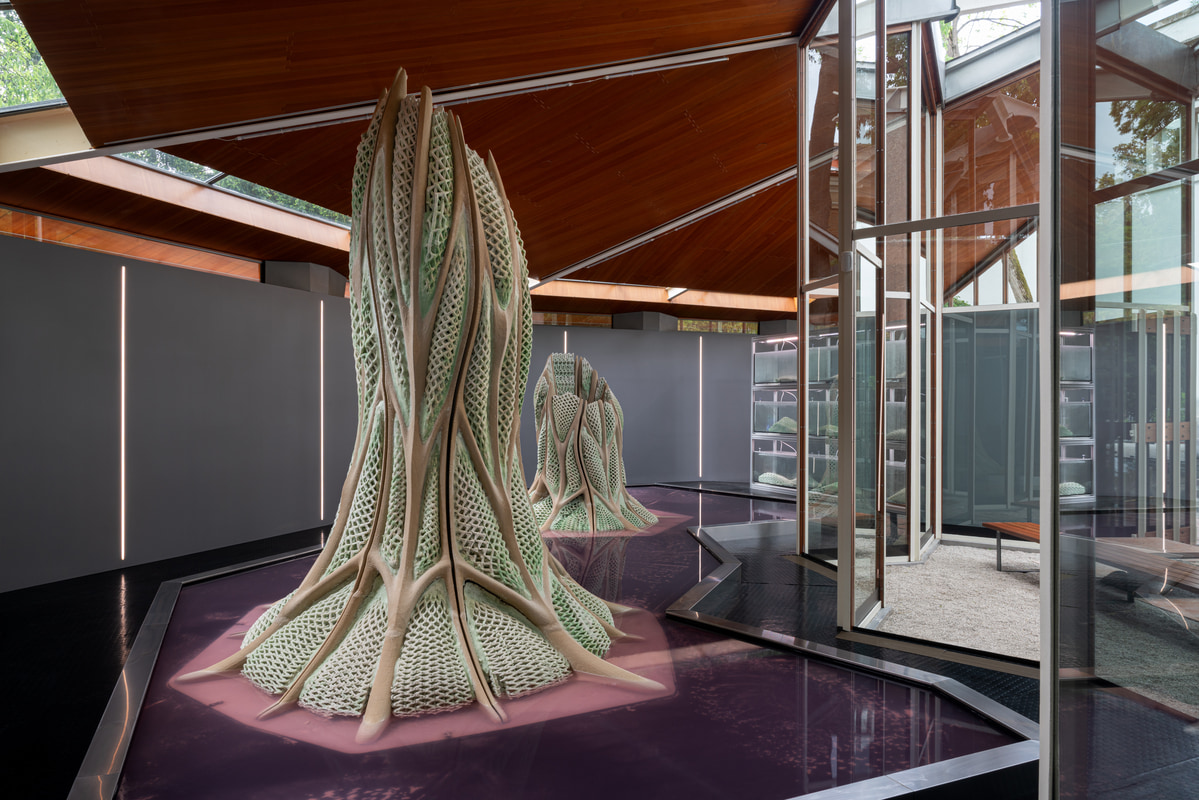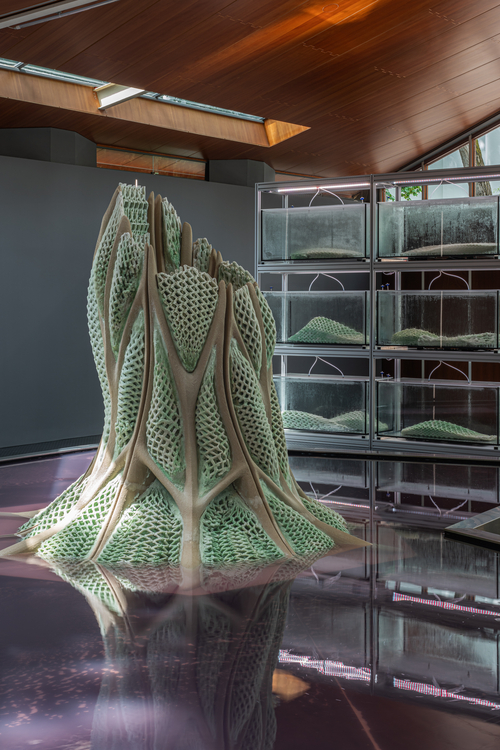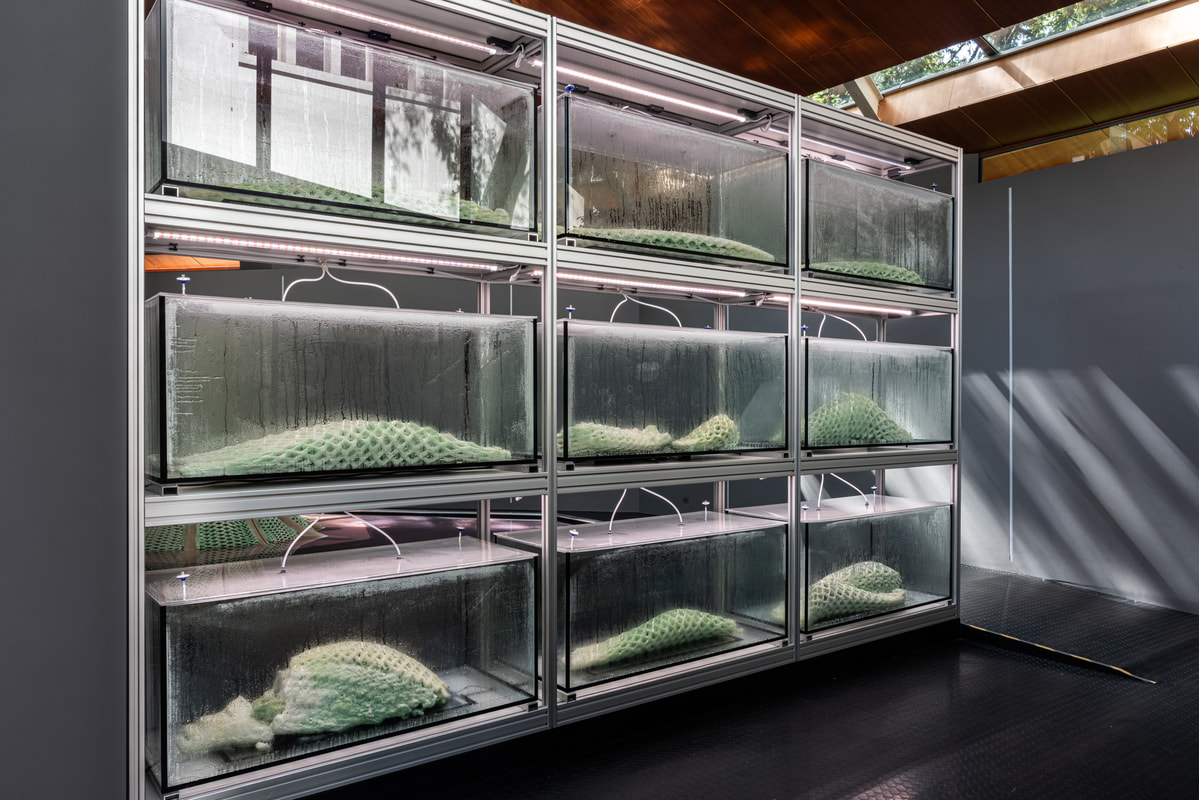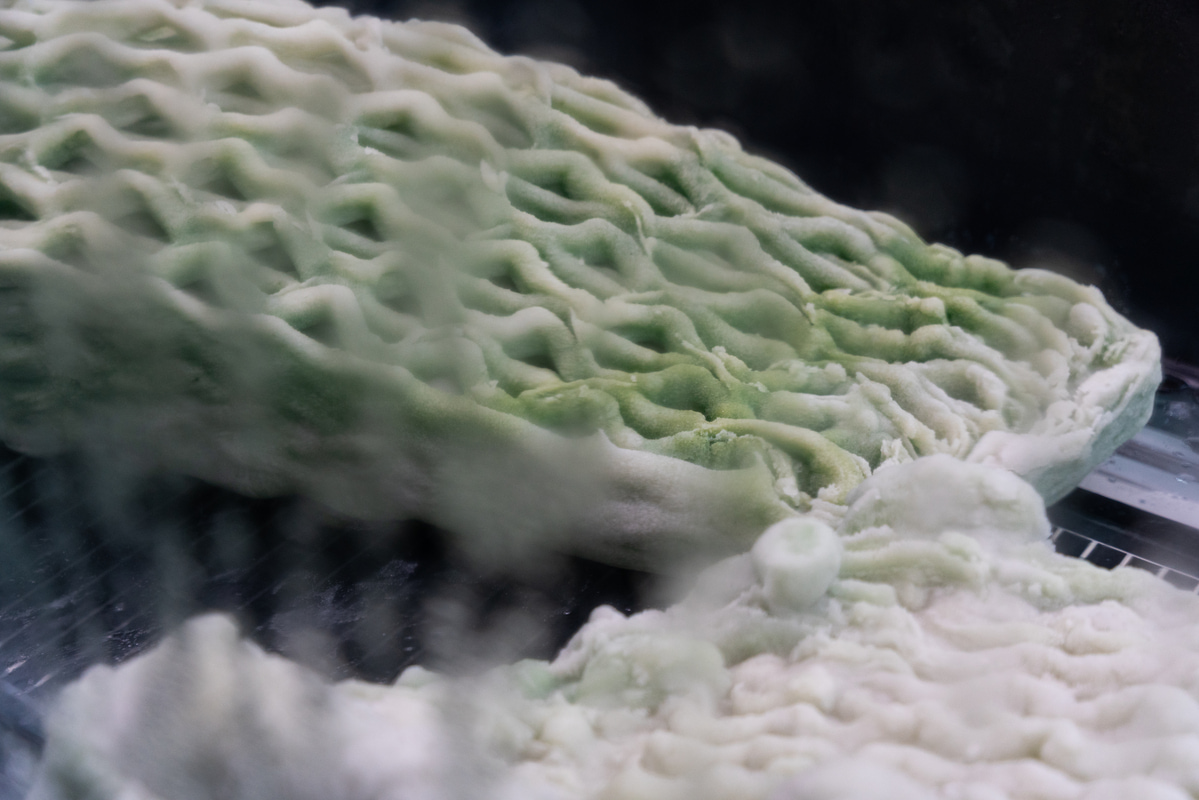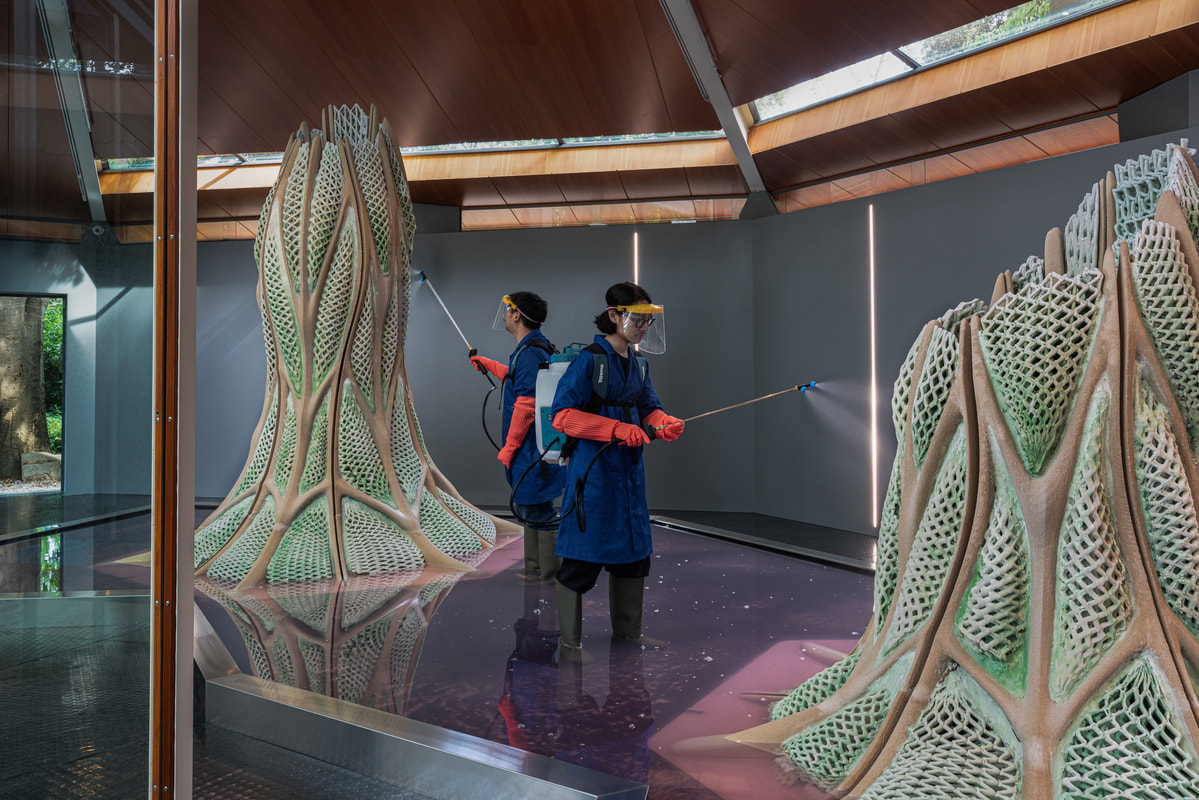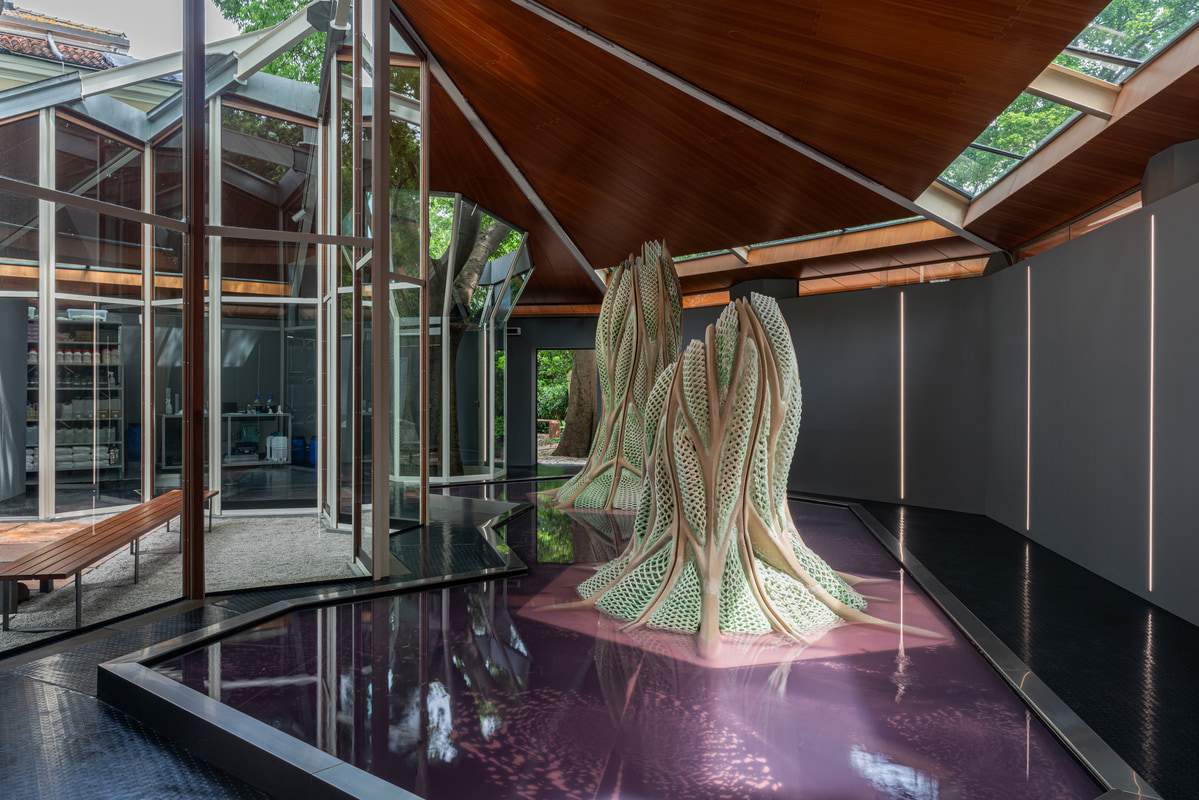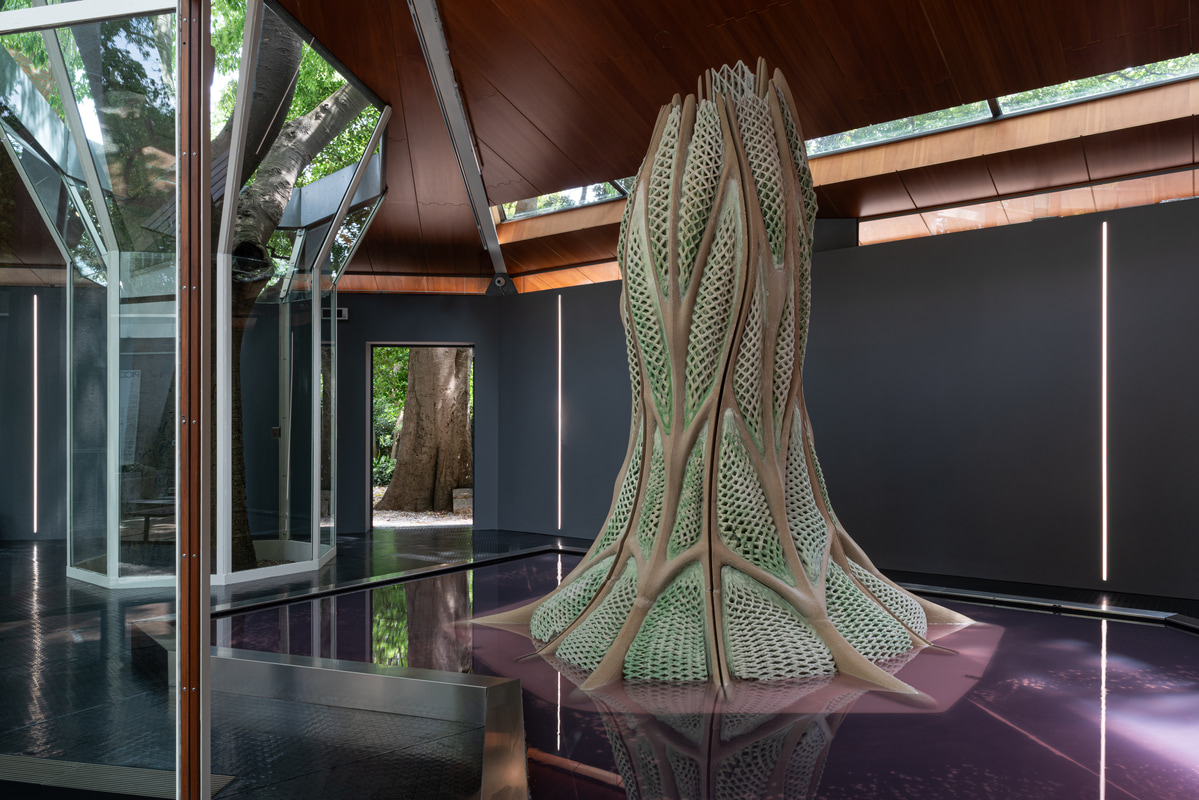Living Room Collective: Picoplanktonics
On the occasion of Canada’s participation in the 19th International Architecture Exhibition – La Biennale di Venezia, the Canada Council for the Arts present Picoplanktonics at the Canada Pavilion, from May 10 to November 23, 2025.
Amidst the ongoing global climate crisis, the Living Room Collective has developed a ground-breaking exhibition that showcases the potential for collaboration between humans and nature. Comprised of 3D printed structures that contain live cyanobacteria capable of carbon sequestration, Picoplanktonics is an exploration of our potential to co-operate with living systems by co-constructing spaces that remediate the planet rather than exploit it.
The Living Room Collective’s exhibition is the culmination of four years of collaborative research by Andrea Shin Ling and various interdisciplinary contributors. It is focused on harnessing the design principles of living systems to develop sustainable, intelligent and resilient materials and technologies for the future. By leveraging ancient biological processes alongside emergent technologies, it proposes designing environments under an ecology-first ethos.

Photo: Beda Schmid
“The Canada Council for the Arts is delighted to unveil Picoplanktonics by the Living Room Collective at the 19th International Architecture Exhibition – La Biennale di Venezia. Through the lens of architecture, this year’s Canadian exhibition brings technological innovation and ecological stewardship together. It is a unique exhibition, sure to inspire global audiences and to ignite important conversations, about how our built environment might better house and use natural systems for a more sustainable future.”
– Michelle Chawla, Director and CEO, Canada Council for the Arts
When visitors enter the Canada Pavilion, they will encounter 3D printed structures that were originally fabricated in an ETH Zürich laboratory. These are the largest living material structures produced using a first-of-its-kind biofabrication platform capable of printing living structures at an architectural scale. The unique Picoplanktonics experience stems from adapting the Canada Pavilion to provide enough light, moisture, and warmth for the living cyanobacteria within the structures to grow, thrive and change. For the duration of the exhibition, caretakers will be onsite tending to the structures, emphasizing care and stewardship as essential elements of the design.
As global carbon emissions continue to rise to untenable levels, Picoplanktonics presents a vision of how a regenerative system of construction could operate. It is an ongoing experiment centered on leveraging the reciprocal relationship between living structures, the built environment, and humans. In this way, the Living Room Collective is rethinking building principles and prioritizing ecological resilience beyond human species survival.
Visit the Picoplanktonics website
“Picoplanktonics marks four years of research at ETH Zürich with international collaborators in material science, biology, robotics, and computational design. As we move these living prototypes into the Canada Pavilion, we are thrilled to invite the public into this open experiment and reveal all phases of the material’s life, including growth, sickness, and death, while collectively imagining a regenerative design approach that seeks planetary remediation.”
–Andrea Shin Ling, The Living Room Collective
The Living Room Collective is a group of architects, scientists, artists and educators who work at the intersection of architecture, biology and digital fabrication technologies—led by Canadian architect and biodesigner Andrea Shin Ling. Alongside core team members Nicholas Hoban, Vincent Hui and Clayton Lee, the collective seeks to move society away from exploitative systems of production to regenerative ones by inventing design methods and processes that center on natural systems.
They see the Biennale Architettura 2025 as a platform to generate national and international conversations that ask: How does one fabricate a biological architecture? What are the conditions of stewardship? What are the strategies to instigate this at scale, regionally and globally?

Photo: Girts Apskalns
Living Room Collective

Andrea Shin Ling is an architect and biodesigner who works at the intersection of design, digital fabrication and biology. Her work focuses on how the critical application of biologically and computationally mediated design processes can move society away from exploitative systems of production to regenerative ones. She is the 2020 S+T+ARTS Grand Prize winner for her work as Ginkgo Bioworks’ creative resident designing the decay of artifacts in order to access material circularity. Andrea is a founder of designGUILD, a Toronto-based art collective, and was a researcher in the Mediated Matter group at the MIT Media Lab, where she worked on Aguahoja I, a 3D-printed bio-material pavilion. She is currently a doctoral fellow at the Chair of Digital Building Technologies at ETH Zurich.

Nicholas Hoban is a computational designer, fabricator and educator. He works at the intersection of computational design, robotics, construction and simulation in pedagogy, research and practice. Nicholas is the director of applied technologies at the John H. Daniels Faculty of Architecture, Landscape, and Design and a lecturer within the Daniels technology specialist program, leading various research and teaching labs while developing curriculum for studios and seminars on advanced fabrication and robotics within architecture. His research focuses on the application of robotics within fabrication and construction and on how we can solve critical problems in geometry through integrated processes. Nicholas was a lead fabricator and computational designer for two previous Venice Biennales: for the 2014 Canadian Pavilion for Lateral Office’s Arctic Adaptations and for the 2016 Swiss Pavilion for Christian Kerez’s Incidental Space.

Vincent Hui is a distinguished professor at Toronto Metropolitan University’s Department of Architectural Science, imparting knowledge across diverse domains from design studios to digital tools. His pedagogical excellence has earned him multiple teaching accolades, as he delves into the intersections of architecture, fabrication and allied disciplines. With over 25 years of experience, his extensive publication portfolio focuses on design pedagogy, simulation, prototyping and technological convergence, complemented by a rich body of creative work showcased globally. Collaborating with esteemed organizations such as the Royal Architectural Institute of Canada (RAIC), the Ontario Association of Architects (OAA) and the Canadian Architecture Students’ Association (CASA), Vincent endeavours to empower the next generation of designers, navigating emergent shifts in praxis. Committed to bridging academia and industry, he advocates for experiential learning initiatives and outreach endeavours for aspiring designers. His remarkable contributions have culminated in his induction into the esteemed RAIC College of Fellows.

Clayton Lee is a curator, producer and performance artist. He is currently the director (artistic) of the Fierce Festival, in Birmingham, UK. He was previously the director of the Rhubarb Festival, Canada’s longest-running festival of new and experimental performance, at Buddies in Bad Times Theatre. Clayton has also worked as creative producer on Jess Dobkin’s projects, including For What It’s Worth, her commission at the Wellcome Collection, in London, UK; as curatorial associate at the Luminato Festival; and as managing producer of the CanadaHub at the Edinburgh Festival Fringe. His performance projects have been presented in venues across Canada, the United States, the United Kingdom and New Zealand. He was one of the Art Gallery of Ontario’s 2023 artists-in-residence.
Research and Development: ETH Zurich-: Andrea Shin Ling, Yo-Cheng Jerry Lee, Nijat Mahamaliyev, Hamid Peiro, Dalia Dranseike, Yifan Cui, Pok Yin Victor Leung, Barrak Darweesh │ Production: ETH Zurich: Huang Su, Wenqian Yang, Che-Wei Lin, Sukhdevsinh Parmar; Tobias Hartmann, Michael Lyrenmann, Luca Petrus, Jonathan Leu, Philippe Fleischmann, Oliver Zgraggen, Paul Fischlin, Mario Hebing, Franklin Füchslin; Hao Wu, Nicola Piccioli-Cappelli, Roberto Innocenti, Sigurd Rinde, Börte Emiroglu, Stéphane Bernhard, Carlo Pasini, Apoorv Singh, Paul Jaeggi; Mario Guala, Isabella Longoni; Toronto Metropolitan University: Venessa Chan, Minh Ton, Daniel Wolinski, Marko Jovanovic, Santino D’Angelo Rozas, Rachel Kim, Alexandra Waxman, Richard McCulloch, Stephen Waldman, Tina Smith, Andrea Skyers, Randy Ragan, Emma Grant, Shira Gellman, Mariska Espinet, Suzanne Porter, Stacey Park, Amanda Wood, Lisa Landrum, Dorothy Johns, Cedric Ortiz; University of Toronto: Daniel Lewycky, Philipp Cop; Additive Tectonics GmbH | Visualisation: Adrian Yu. Nazanin Kazemi, Ariel Weiss│ Structural Advisors: Andrea Menardo, Kam-Ming Mark Tam | Graphic Design: Shannon Lin │ Website: Sigurd Rinde, Shannon Lin │ Local Project Logistics: Tamara Andruszkiewicz │ Project Advisors: ETH Zurich: Benjamin Dillenburger, Mark Tibbitt
Picoplanktonics is made possible by the generous support from the Canada Council, Digital Building Technologies, Institute of Technology & Architecture, D-ARCH, ETH Zurich; Department of Architectural Science, Toronto Metropolitan University; and John H. Daniels Faculty of Architecture, Landscape and Design, University of Toronto. As well, acknowledges the important additional support of the Royal Architectural Institute of Canada; Advanced Engineering with Living Materials (ALIVE) Initiative, ETH Zurich; Additive Tectonics GmbH; ABB Switzerland; Vestacon Limited and NEUF Architect(e)s.
Selection committee
The selection committee was comprised of:
- Aziza Chaouni, architect, principal, Aziza Chaouni Projects (Toronto │ Morocco) │ associate professor, John H. Daniels Faculty of Architecture, Landscape, and Design, University of Toronto (Toronto, Ontario)
- David Garneau (Métis), painter, curator and critical art writer │ professor, Visual Arts Department, University of Regina (Regina, Saskatchewan)
- Daniel Pearl, architect, principal, L’OEUF Architectes (Montréal) │ professor, School of Architecture, Université de Montréal (Montréal, Quebec)
- Siamak Hariri, architect, founding partner, Hariri Pontarini Architects (Toronto, Ontario)
- Sepake Angiama, curator and educator │ artistic director, Institute for International Visual Art (London, United Kingdom)
Media relations contact
For media requests including interviews, please contact:
Canada Council for the Arts
Communications and Engagement
613-239-3958 | 1-800-263-5588, extension 5151
Media Kit
Press release, backgrounders, biographies and images may be downloaded at the following link:










